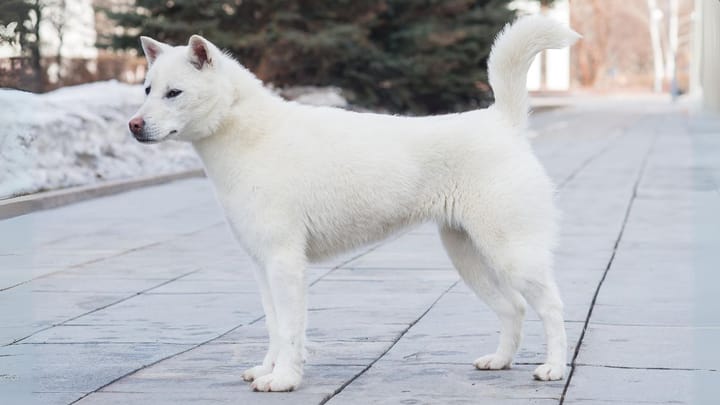Kishu
Other names : Kishu Inu, Kishu Ken

This loyal and vigilant dog is only around 60% as serious as he looks. Yes, he is disinterested in strangers (perhaps a healthy trait) and often cold towards his own kind, but he can also be fiercely affectionate towards his chosen confidants and enjoys a game as befits his sporting heritage. Native to Japan, where he is descended from the hunting dogs of the Wakayama and Mie Prefecture mountains, he is celebrated as one of his home country’s six ‘national monument’ breeds. His distinctive sickle-shaped brush tail, white, red, or sesame coat, and blissful expression have made his name beyond the shores of his home island.
|
Life expectancy |
The Kishu has a life expectancy of between 11 and 13 years |
|
Temperament |
|
|
Size |
Medium
|
|
Adult size |
Female
Between 18 and 20 in
Male
Between 19 and 22 in
|
|
Adult weight |
Female
Between 44 and 55 lb
Male
Between 44 and 55 lb
|
|
Coat colour
White, red, or sesame (even mixture of black, red, and white hairs). |
Black White Red |
|
Type of coat
Harsh outer coat and soft, dense undercoat. |
Short |
|
Eye colour
Dark brown. |
Brown
|
Finding an available Kishu Ken in the UK is a lengthy process. Originally, these dogs’ coats had red or sesame spots or streaks, but from 1934 only uniform coats were admitted, and spotted coats disappeared by 1945. Nowadays, a white coat is not uncommon.
More details about the Kishu
Kishu: Origins and history
The Kishu Ken can trace his heritage to a 3,000-year line of spitz-type hunting dogs of Japan’s mountain regions. In later centuries, they were selectively bred for their skills and also their colour, so that by 1945 the spotty varieties had all disappeared. In 1934, this proud dog became a “Memorial of Nature” in his homeland.
Physical characteristics of the Kishu
This wolfish fellow has something of the seriousness of the Alsatian about his person, but with an Asian twist. Most commonly white in colour, and always without spots, stripes, and other patterns, his strong bone structure and searching eyes make him stand out in a crowd. He has a broad forehead, triangular, inclining eyes, and wolfish ears, although his aloof expression deprives him of the sensuality of the canis lupus. Still, he backs-up an already-attractive package with a tail apparently built for pleasure.
FCI classification of the Kishu
-
Group 5 - Spitz and primitive types
-
Section 5 : Asian Spitz and related breeds
Kishu: Characteristics
Kishu: Behaviour
Training a Kishu
He is a clever dog and a quick learner, who is receptive when a relationship of mutual trust has been established. The Kishu pup must learn the basics early to become the wonderful companion he deserves to be.
Kishu: Lifestyle
Breed compatibility Kishu
Kishu: Purchase price
We do not have enough data to set an average price. Looking after a dog of this size typically costs between £70 to £110 a month, including food, medical/insurance, and incidental expenses.
Kishu: Grooming
A weekly brush and/or bath should do the job nicely.
Kishu: Health
Other than his allergies (certain foods and environmental factors) the Kishu Ken keeps pretty good health and has an average life expectancy of 12 years.
This is a robust outdoors-type dog, who is predisposed to some problems specific to Japanese breeds.
Beware of heat stroke; this breed is not made to withstand high temperatures.
His double coat gives him excellent protection against cold and damp.
Not especially, unless he is suffering from hypothyroidism, which is not uncommon among the Kishu Ken.
- Hypothyroidism
- Entropion
- Food or environmental allergies



